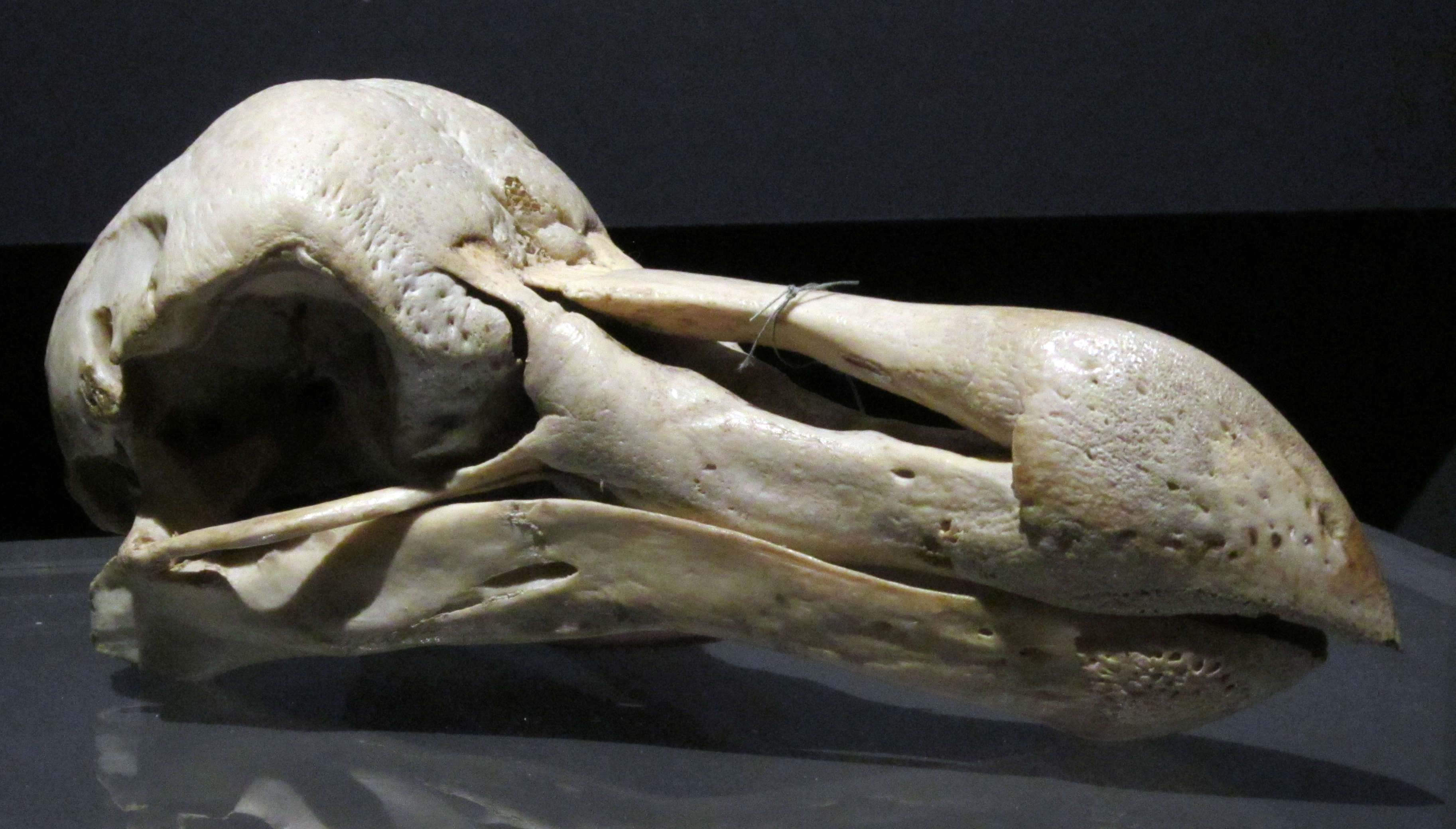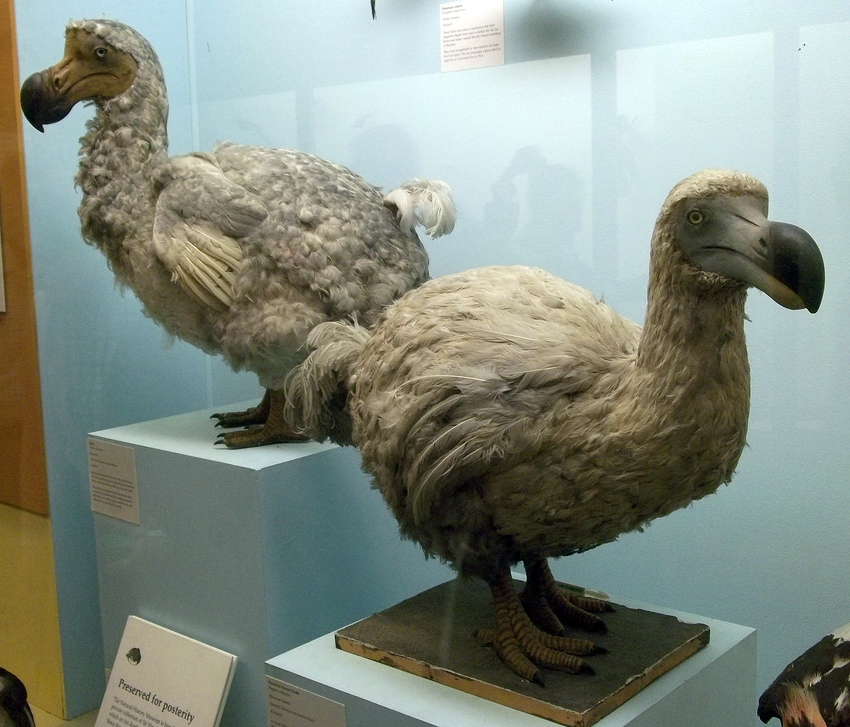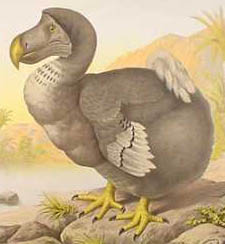|
Dodo
The dodo (''Raphus cucullatus'') is an extinct flightless bird that was endemic to the island of Mauritius, which is east of Madagascar in the Indian Ocean. The dodo's closest genetic relative was the also-extinct Rodrigues solitaire. The two formed the subfamily Raphinae, a clade of extinct flightless birds that were a part of the family which includes pigeons and doves. The closest living relative of the dodo is the Nicobar pigeon. A white dodo was once thought to have existed on the nearby island of Réunion, but it is now believed that this assumption was merely confusion based on the also-extinct Réunion ibis and paintings of white dodos. Subfossil remains show the dodo was about tall and may have weighed in the wild. The dodo's appearance in life is evidenced only by drawings, paintings, and written accounts from the 17th century. Since these portraits vary considerably, and since only some of the illustrations are known to have been drawn from live specim ... [...More Info...] [...Related Items...] OR: [Wikipedia] [Google] [Baidu] |
Réunion Ibis
The Réunion ibis or Réunion sacred ibis (''Threskiornis solitarius'') is an extinct species of ibis that was endemic to the volcanic island of Réunion in the Indian Ocean. The first subfossil remains were found in 1974, and the ibis was first scientifically described in 1987. Its closest relatives are the Malagasy sacred ibis, the African sacred ibis, and the straw-necked ibis. Travellers' accounts from the 17th and 18th centuries described a white bird on Réunion that flew with difficulty and preferred solitude, which was subsequently referred to as the "Réunion solitaire". In the mid 19th century, the old travellers' accounts were incorrectly assumed to refer to white relatives of the dodo, due to one account specifically mentioning dodos on the island, and because 17th-century paintings of white dodos had recently surfaced. However, no fossils referable to dodo-like birds were ever found on Réunion, and it was later questioned whether the paintings had anything to do ... [...More Info...] [...Related Items...] OR: [Wikipedia] [Google] [Baidu] |
Raphinae
The Raphinae are a clade of extinct flightless birds formerly called didines or didine birds. They inhabited the Mascarene Islands of Mauritius and Rodrigues, but became extinct through hunting by humans and predation by introduced non-native mammals following human colonisation in the 17th century. Historically, many different groups have been named for both the dodo and the Rodrigues solitaire, not all grouping them together. Most recently, it is considered that the two birds can be classified in Columbidae, often under the subfamily Raphinae. The first person to suggest a close affinity to the doves was Johannes Theodor Reinhardt, whose opinions were then supported by Hugh Edwin Strickland and Alexander Gordon Melville. Recent extractions of DNA from the dodo and Rodrigues solitaire, as well as 37 species of doves, has found where in Columbidae the raphines should be placed. Surprisingly, raphines are not the most primitive columbid, instead they are grouped with the ... [...More Info...] [...Related Items...] OR: [Wikipedia] [Google] [Baidu] |
Rodrigues Solitaire
The Rodrigues solitaire (''Pezophaps solitaria'') is an extinct flightless bird that was endemic to the island of Rodrigues, east of Madagascar in the Indian Ocean. Genetically within the family of pigeons and doves, it was most closely related to the also extinct dodo of the nearby island Mauritius, the two forming the subfamily Raphinae. The Nicobar pigeon is their closest living genetic relative. Rodrigues solitaires grew to the size of swans, and demonstrated pronounced sexual dimorphism. Males were much larger than females and measured up to in length and in weight, contrasting with and for females. Its plumage was grey and brown; the female was paler than the male. It had a black band at the base of its slightly hooked beak, and its neck and legs were long. Both sexes were highly territorial, with large bony knobs on their wings that were used in combat. The Rodrigues solitaire laid a single egg that was incubated in turn by both sexes. Gizzard stones helped digest ... [...More Info...] [...Related Items...] OR: [Wikipedia] [Google] [Baidu] |
Mare Aux Songes
The Mare aux Songes () swamp is a lagerstätte located close to the sea in south eastern Mauritius. Many subfossils of recently extinct animals have accumulated in the swamp, which was once a lake, and some of the first subfossil remains of dodos were found there. History In 1865, government schoolmaster at Mahébourg, George Clark, finally found an abundance of subfossil dodo bones in the swamp of Mare aux Songes in Southern Mauritius, after searching for thirty years, having been inspired by Strickland & Melville's monograph about the bird. In 1866, Clark explained his procedure to The Ibis, an ornithology journal: Remains of over 300 dodos were found in the swamp, but only very few skull and wing bones among them, which may be explained by the upper bodies having been washed away or scavenged while the lower body was trapped, which is similar to the way many moa remains have been found in New Zealand marshes. In 1889, Théodor Sauzier was commissioned to find more dodo remai ... [...More Info...] [...Related Items...] OR: [Wikipedia] [Google] [Baidu] |
Alice's Adventures In Wonderland
''Alice's Adventures in Wonderland'' (commonly ''Alice in Wonderland'') is an 1865 English novel by Lewis Carroll. It details the story of a young girl named Alice who falls through a rabbit hole into a fantasy world of anthropomorphic creatures. It is seen as an example of the literary nonsense genre. The artist John Tenniel provided 42 wood-engraved illustrations for the book. It received positive reviews upon release and is now one of the best-known works of Victorian literature; its narrative, structure, characters and imagery have had widespread influence on popular culture and literature, especially in the fantasy genre. It is credited as helping end an era of didacticism in children's literature, inaugurating a new era in which writing for children aimed to "delight or entertain". The tale plays with logic, giving the story lasting popularity with adults as well as with children. The titular character Alice shares her given name with Alice Liddell, a girl Carroll knew ... [...More Info...] [...Related Items...] OR: [Wikipedia] [Google] [Baidu] |
Bird Extinction
Out of the approximately 11,154 known bird species, 159 (1.4%) have become extinct, 226 (2%) are critically endangered, 461 (4.1%) are endangered, 800 (7.2%) are vulnerable and 1,018 (9.1%) are near threatened. There is a general consensus among scientists who study these trends that if human impact on the environment continues as it has, one-third of all bird species and an even greater proportion of bird populations will be gone by the end of this century. Since 1500, 150 species of birds have become extinct. Historically, the majority of bird extinctions have occurred on islands, particularly those in the Pacific. These include countries such as New Zealand, Australia, Fiji, and Papua New Guinea. Some species are not extinct and seem numerous, but exist in highly reduced numbers from previous years. For example, the Wood Thrush population in North America has declined 50% in the last 50 years. According to the American Bird Conservatory, in the Western Hemisphere 12% of bird ... [...More Info...] [...Related Items...] OR: [Wikipedia] [Google] [Baidu] |
Columbidae
Columbidae () is a bird family consisting of doves and pigeons. It is the only family in the order Columbiformes. These are stout-bodied birds with short necks and short slender bills that in some species feature fleshy ceres. They primarily feed on seeds, fruits, and plants. The family occurs worldwide, but the greatest variety is in the Indomalayan and Australasian realms. The family contains 344 species divided into 50 genera. Thirteen of the species are extinct. In English, the smaller species tend to be called "doves" and the larger ones "pigeons". However, the distinction is not consistent, and does not exist in most other languages. Historically, the common names for these birds involve a great deal of variation between the terms. The bird most commonly referred to as just "pigeon" is the domestic pigeon, which is common in many cities as the feral pigeon. Doves and pigeons build relatively flimsy nests, often using sticks and other debris, which may be placed on ... [...More Info...] [...Related Items...] OR: [Wikipedia] [Google] [Baidu] |
Flightless Bird
Flightless birds are birds that through evolution lost the ability to fly. There are over 60 extant species, including the well known ratites (ostriches, emu, cassowaries, rheas, and kiwi) and penguins. The smallest flightless bird is the Inaccessible Island rail (length 12.5 cm, weight 34.7 g). The largest (both heaviest and tallest) flightless bird, which is also the largest living bird, is the ostrich (2.7 m, 156 kg). Many domesticated birds, such as the domestic chicken and domestic duck, have lost the ability to fly for extended periods, although their ancestral species, the red junglefowl and mallard, respectively, are capable of extended flight. A few particularly bred birds, such as the Broad Breasted White turkey, have become totally flightless as a result of selective breeding; the birds were bred to grow massive breast meat that weighs too much for the bird's wings to support in flight. Flightlessness has evolved in many different birds independen ... [...More Info...] [...Related Items...] OR: [Wikipedia] [Google] [Baidu] |
Nicobar Pigeon
The Nicobar pigeon (''Caloenas nicobarica'', Car: ') is a bird found on small islands and in coastal regions from the Andaman and Nicobar Islands, India, east through the Malay Archipelago, to the Solomons and Palau. It is the only living member of the genus ''Caloenas'' alongside the extinct spotted green pigeon, and is the closest living relative of the extinct dodo and Rodrigues solitaire. Taxonomy In 1738, the English naturalist Eleazar Albin included a description and two illustrations of the Nicobar pigeon in his ''A Natural History of Birds''. When in 1758 the Swedish naturalist Carl Linnaeus updated his ''Systema Naturae'' for the tenth edition, he placed the Nicobar pigeon with all the other pigeons in the genus ''Columba''. Linnaeus included a brief description, coined the binomial name ''Columba nicobarica'' and cited Albin's work. The species is now placed in the genus ''Caloenas'' erected by English zoologist George Robert Gray in 1840 with the Nicobar pigeon as ... [...More Info...] [...Related Items...] OR: [Wikipedia] [Google] [Baidu] |
Mauritius
Mauritius ( ; french: Maurice, link=no ; mfe, label= Mauritian Creole, Moris ), officially the Republic of Mauritius, is an island nation in the Indian Ocean about off the southeast coast of the African continent, east of Madagascar. It includes the main island (also called Mauritius), as well as Rodrigues, Agaléga and St. Brandon. The islands of Mauritius and Rodrigues, along with nearby Réunion (a French overseas department), are part of the Mascarene Islands. The main island of Mauritius, where most of the population is concentrated, hosts the capital and largest city, Port Louis. The country spans and has an exclusive economic zone covering . Arab sailors were the first to discover the uninhabited island, around 975, and they called it ''Dina Arobi''. The earliest discovery was in 1507 by Portuguese sailors, who otherwise took little interest in the islands. The Dutch took possession in 1598, establishing a succession of short-lived settlements over a perio ... [...More Info...] [...Related Items...] OR: [Wikipedia] [Google] [Baidu] |
Extinction
Extinction is the termination of a kind of organism or of a group of kinds (taxon), usually a species. The moment of extinction is generally considered to be the death of the Endling, last individual of the species, although the Functional extinction, capacity to breed and recover may have been lost before this point. Because a species' potential Range (biology), range may be very large, determining this moment is difficult, and is usually done retrospectively. This difficulty leads to phenomena such as Lazarus taxon, Lazarus taxa, where a species presumed extinct abruptly "reappears" (typically in the Fossil, fossil record) after a period of apparent absence. More than 99% of all species that ever Life, lived on Earth, amounting to over five billion species, are estimated to have died out. It is estimated that there are currently around 8.7 million species of eukaryote globally, and possibly many times more if microorganisms, like bacteria, are included. Notable extinct a ... [...More Info...] [...Related Items...] OR: [Wikipedia] [Google] [Baidu] |
Indian Ocean
The Indian Ocean is the third-largest of the world's five oceanic divisions, covering or ~19.8% of the water on Earth's surface. It is bounded by Asia to the north, Africa to the west and Australia to the east. To the south it is bounded by the Southern Ocean or Antarctica, depending on the definition in use. Along its core, the Indian Ocean has some large marginal or regional seas such as the Arabian Sea, Laccadive Sea, Bay of Bengal, and Andaman Sea. Etymology The Indian Ocean has been known by its present name since at least 1515 when the Latin form ''Oceanus Orientalis Indicus'' ("Indian Eastern Ocean") is attested, named after India, which projects into it. It was earlier known as the ''Eastern Ocean'', a term that was still in use during the mid-18th century (see map), as opposed to the ''Western Ocean'' ( Atlantic) before the Pacific was surmised. Conversely, Chinese explorers in the Indian Ocean during the 15th century called it the Western Oceans. In Anc ... [...More Info...] [...Related Items...] OR: [Wikipedia] [Google] [Baidu] |










.jpg)
